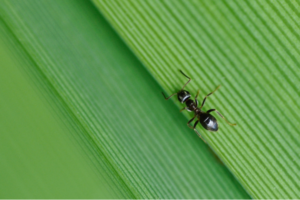The long winter is finally behind us! With these warmer days comes an eagerness to be outside, enjoying the long-awaited sun from our own backyards. But alas, we are not the only ones emerging. Yeah, you know them: the ants, spiders, ticks, mosquitoes, and other small bugs that can put a damper on outdoor time. Although I consider myself to be a respectful admirer of nature, I will go mama bear on any bug or arachnid that carries the potential to harm my children’s health. So when I think spring, I also think of pest prevention.
Yet, I’m not about to douse my yard in pesticides. My kids play here so it’s important to me to keep them safe as well as minimize the toxins in our home. Here are some ways we fight the pests in our yard without harming ourselves or the environment.
1. Plant It.
Strategically planting certain herbs, annuals, and perennials around the home’s exterior can ward off insects and other pests. Even container pots filled with particular herbs can make a difference. For example, did you know that spiders hate Peppermint? Or that the Chrysanthemum flower not only repels ants and spiders, but also pests like roaches, Japanese beetles, ticks, fleas, and mites? Planting these kinds of seedlings is effective not just because of their repellent properties. As a result of these plants, your yard becomes more visually and aromatically appealing!
Pest Repellant Plants:
- Citronella: mosquito repellent
- Lemon Eucalyptus: mosquito repellent
- Geranium: mosquito & fly repellent
- Lemon Balm: mosquito repellent
- Ageratum: mosquito repellent
- Lavender: mosquito, chigger, tick, fly & flea repellent
- Catnip: mosquito repellent
- Lemongrass: mosquito, chigger, tick, fly & flea repellent
- Basil: mosquito repellent
- Peppermint: spider & ant repellent
- Lemon Thyme: mosquito repellent
- Rosemary: mosquito, flea & tick repellent
- Horsemint: mosquito repellent
- Marigold: mosquito repellent
For more information on repellant plants, check out this comprehensive post by Hippie Homemaker blogger, Christina Athis. You can also visit your local nursery. Our favorites are Rolling Green in Greenland and Churchill’s in Exeter. Or, if it’s Farmers Market season, purchase from your local farmer!
2. Spray It.
If you’re like our family then you have a curious collection of outdoor toys decorating your yard. While they conveniently await imaginative play on sunny days, they can become a campground for critters like spiders or mosquitoes. It’s even worse if they have pockets where rain water can collect. Thus, making your own repellent spray is an easy way to turn away bugs and keep storage spaces and toys smelling nice. I personally like to use a blend of essential oils, distilled water, and white vinegar in my sprays so that we avoid unnecessary toxins in our play areas. Becuase this spray will wash away after a rain fall, regular application can help to deter insects and unwanted pests (mice included!).

What You’ll Need:
- 10 drops Lemongrass Essential Oil
- 10 drops Eucalyptus Essential Oil
- 10 drops Melaleuca Essential Oil
- 10 drops Peppermint Essential Oil
- 1 TBSP White Vinegar
- Distilled Water
- 4oz. glass spray bottle (preferably amber or cobalt blue to shield UV rays)
- a glass medicine dropper
To Make:
Using the glass dropper, add each of the essential oils to the glass spray bottle and swirl gently to combine. Next, add the vinegar and top off the distilled water to fill the rest of the bottle. Finally, return the spray top to the bottle and shake well before each use. It’s important to note that storing the mix in a cool, dark place is best for preservation purposes. To get your hands on high-quality essential oils for this recipe, consider visiting local clean living shop Jane Gee of Portsmouth. Alternatively, you can also support a local mompreneur who represents dōTERRA essential oils.
3. Sprinkle It.
Similarly to spraying or planting, sprinkling has its perks. Adding a dash of cinnamon, cassia, or cloves to the sandbox is my new favorite way to use my baking spices. Why? For some reason, spiders, ants, and other bugs despise the smell (and taste). Due to their antimicrobial properties, these spices can actually help to keep these play areas (slightly) cleaner. Don’t believe me? Check this research study out to learn more!
To use this method, add one tablespoon of the spice to your sandbox by sprinkling it around the surface area. Next, toss the sand by hand to mix the spice in, particularly among the interior perimeter and corners of the pit. Dried basil, thyme, and lavender can also be sprinkled into sand boxes in this fashion if you want to keep your baking spices in the kitchen.











Great read! Thank you.
Comments are closed.